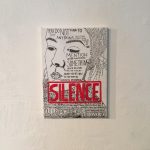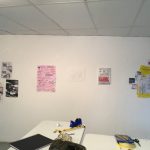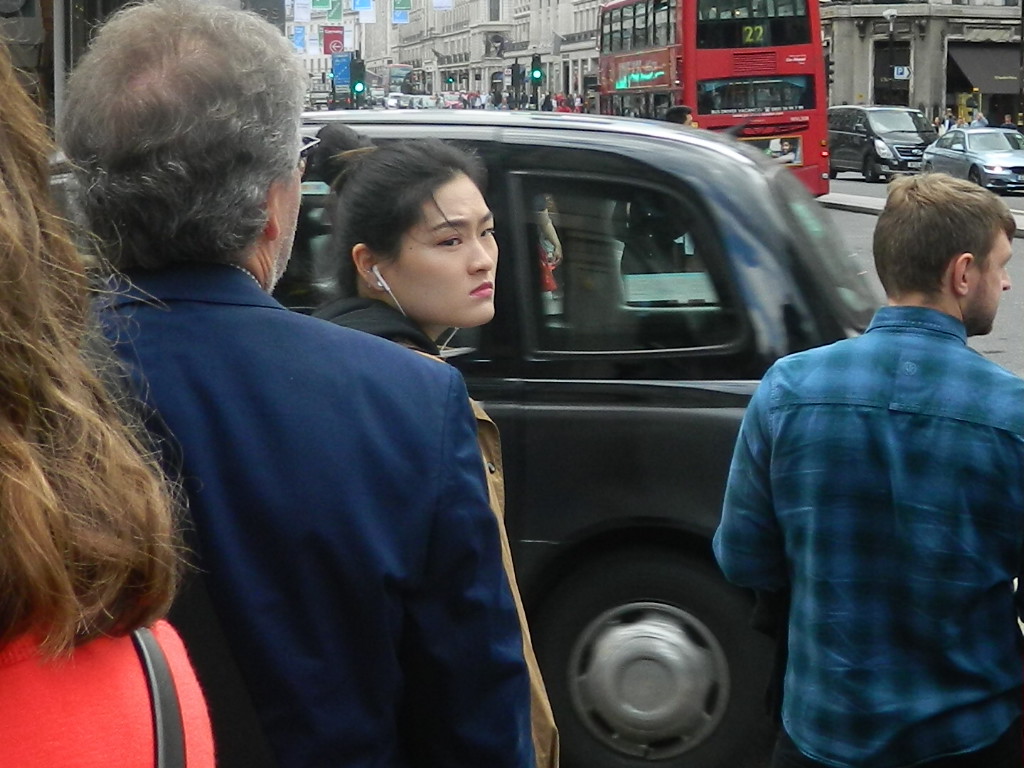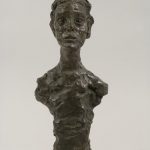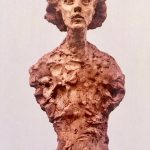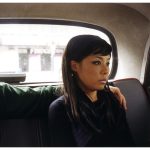My piece of work for ‘Manifesto’ was a 35 x 25 cm canvas. I was originally going to produce x3 of these with different self-portraits, containing a different message in each one which is why it was so small. However due to not having enough time I only produced one, thinking sometimes less is more. I was happy with the way it turned out but the only thing I would change is the size of the canvas. I wouldn’t complicate or simplify the piece but I would probably make it a lot neater and more defined rather than some of the writing being wonky and messy in places. My ‘Manifesto’ piece contains a strong meaning and personally I feel a work of this depth belongs on a larger scale for all audiences to see.
Author Archives: Emily-Jayne Ponting
Emily-Jayne Ponting: Fine Art: Research and Communication Skills (Task 11)
When summarising my blog I would say that the process of development has helped me define my mode of practise in a lot more depth. I have also become aware that I do not have to produce an oil piece from every photograph I take for it to become art. But that I am actually quite fond of photography and my images alone are strong enough to represent my practise. I am happy where my work is at right now and I believe this blog has only emphasised that for me as an artist.
I found ‘Task 7’ quite challenging for me and I think this was purely down to the use of strong vocabulary; however I enjoy a good challenge. In comparison I feel that ‘Task 9’ got me thinking about why I have such a raw passion for my study and this is always important.
Emily-Jayne Ponting: Fine Art – Research and Communication Skills (Task 10)
‘Look close enough and you will find many hidden treasures.’
As an artist I find myself exploring the general public. I go out with my camera and take photographs of anything that I am drawn to and more often than not this is the unnoticed. The above image was taken at Oxford Street in London a few months ago and I have used it to represent my practise purely because it does exactly this. Oxford Street is a well-known tourist attraction and within the image defines this, such as the obvious black cab and big red bus. But as you can see those were not my focus – the taxi and bus is blurred – at all, the lady was. My quote explains exactly this, most people go to London to see the ‘obvious black cab and big red bus’ but I look closer than this and by doing so I believe I find many hidden treasures.
Emily-Jayne Ponting: Fine Art – Research and Communication Skills (Task 9)
Beuford Smith
Woman Bathing/Madonna, NY, 1967
Photograph, gelatin silver print on paper 34.3 x 25.4
‘It is a peculiar sensation, this double-consciousness, this sense of always looking at one’s self through the eyes of others.’ Observation by DuBoi’s
Beuford Smith was a self-taught photographer. I became aware of his work as an artist when visiting the Souls of a Nation exhibition back in August this year and I was drawn to the way he interpreted his work. After looking into other photographers of interest to me, such as Dawoud Bey and Roy DeCarava – both found in the same exhibition – I saw similarities within their work and I was rightly to do so as I became aware of this… ‘In 1963 – in the midst of the Civil Rights Movement – a group of fifteen black photographers got together to critique and nurture each other. In Kenya’s Kikuyu language, “kamoinge” means a group of people acting together. Roy DeCarava was the group’s first director.’
Now aware of the group of photographers Beuford Smith was a part of and the Souls of a Nation Exhibition focusing on race around the 60’s in America; it became easier for me to understand from my research the pure emotion I was feeling from the pieces of work shown in front of me that I didn’t fully understand the theory behind.
‘I don’t think you can overstate how important this group is, historically, socially, and aesthetically. During the upheaval of the 1960s – the needless violence, murders, and sanctioned suppression – these photographers documented something only they could have seen, a world that was completely separate from what was shown by Hollywood, television, and mainstream mass media to the rest of American culture.’
Besides all of this knowledge you now know I am going to inform you on how I saw the ‘Woman Bathing’ before I gathered my initial research and notice how my description becomes relevant to the above detail without intentions.
Firstly I noticed the colour of the image and even though black and white photographs were representing a classic era in the 60’s; I felt an automatic dark and eerie feel. Her surroundings are also unsteady and broken – looking at the gate behind her – and due to her body positioning – clutching her face – I can only guess this may be how she’s feeling. She is clearly a pregnant lady and she shouldn’t be stood in a vulnerable dangerous area on her own. However by the title of the image ‘Woman Bathing’ this is where she is expected to wash. Where is her clothing? Who is looking after her? Does anyone care? The rain also emphasises her sadness and it hides her tears, if there are any?
From my description above this lady photographed doesn’t seem to be of any relevance to anyone. Her vulnerable state only emphasises how poorly black people were treated in America at that time and Beuford Smith has captured this aspect superbly.
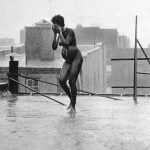
Bibliography:
https://hyperallergic.com/362633/black-lives-photographs-by-beuford-smith-keith-de-lellisgallery-2017/
https://thekamoingeblog.wordpress.com/2015/03/23/fellow-photographer-and-president-emeritus-beuford-smith-on-kamoinge/
Emily-Jayne Ponting: Fine Art – Research and Communication Skills (Task 8)
This piece of work was produced for The Contemporary project and I appropriated a photograph taken by Roy DeCarava. I found the image after going to the TATE Modern Exhibition in London, ‘Souls of a Nation’ and purchasing the book edited by Mark Godfrey and Zoe Whitley. I don’t normally work in black and white, but I was drawn to this image as the human form was the main focus within the photograph and that is what I normally look for when taking my own pictures. For example when visiting Oxford Street I took a few photographs and edit them so that people of interest became the attraction rather than the area itself. When finding inspiration I sometimes reinterpret other photographers work, however if I am going to label it my own the outcomes that I produce will be from my camera shots. I do normally like to work with oil paint but I decided not to with this piece as there was no colour to add so I experimented with charcoal, light and dark, whilst blending the different contrasts together. The materials used were a good choice as the blending worked nicely to recreate the shadows and shading where needed.
Emily-Jayne Ponting: Fine Art – Research and Communication Skills (Task 7)
After reading the given texts I can summarise that Leo Steinberg wrote a book in 1972 called ‘Other Criteria’ containing essays, one of which he explored ‘The Flatbed Picture Plane’. The Picture Plane I believe is a flat surface; a symbolic allusion for hard surfaces such as table tops and studio floors where data is entered in different ways from different materials by different artists. Steinberg talks about various mark making methods such as printing and painting including a flatbed printing press. He also talks about the picture plane of the 1960’s in correspondence with the erect human posture touching on realism, cubism and abstract expressionism. He defines the term flatbed as changing the relationship between artist and image, image and viewer.
Furthermore, the article on Richard Serra is based around his sculpture work and informs the reader that in the late 1960’s he began three-dimensional works exploiting heavy materials and their properties. In the 1970’s and 80’s he worked with steel units and his work maintained a critical presence. Unlike Steinberg, Serra relies upon industrial sector to build work and relates to the urban landscape and architectural enclosure producing work outside of the studio focusing on the relationship between sculpture and context. The use of materials and location matter to Serra, where as I feel Stenberg can relate more to a studio practice and a flat surface. Both artists mention Picasso and Warhol in their work but from different angles.
Emily-Jayne Ponting: Fine Art – Research and Communication Skills (Task 6)
Evolving Oil Painting
I would like to expand my photography taken into clear, detailed oil paintings ideally on canvas. The knowledge behind this is to expand my work into different mediums and to demonstrate my inspiration into a variety of outcomes with my main focus being the general public; revealing hidden treasures that would normally be missed without attention being drawn towards it. This practise would be feasible for me as I own a camera and resources such as printing ink and painting materials would be affordable. It is also quite clear that the larger the scale of work the more expensive it is going to be as more materials are going to be used and I would need to be aware of this when completing my study. I would like to develop my work by researching other portrait artists that are relevant to the work I am trying to portray at the time by visiting local exhibitions and using relevant research materials.
Emily-Jayne Ponting: Fine Art – Research and Communication Skills (Task 5)
Barkley L.Hendricks
Icon For My Man Superman, 1969, 151.1 x 121.9
(Superman Never Saved any Black People-Bobby Seale)
Oil Paint, Acrylic Paint and Aluminium Leaf on Canvas
When I visited the exhibition ‘Soul of a Nation-Art in the Age of Black Power’ at TATE Modern, I was drawn to pure confidence behind the above painting by artist Barkley L.Hendricks. The show of work was about tackling equal rights of Black artists over the two decades in America after 1963 and representing their freedom.
‘A nation where they will not be judged by the colour of their skin but by the content of their character’
For me as soon as I saw the self-portrait I was drawn to its bright colours that hung within the three-stripe border invoking the American flag and the novelty T-shirt worn boldly by the black character. I was aware of the piece appearing in the exhibition as it was presented on the covers of the leaflets given. However there was something about witnessing such a meaningful empowering piece of artwork that made my skin crawl. As an individual artist I am always eager to present art that contains a strong in depth meaning of some sort and could intentionally change my audience’s opinions. With this piece I felt exactly that and seeing the work ‘in the flesh’ I was able to consume the artist’s emotions from a stronger source. The materials used were also perfect and complimented the whole aspect behind the composition.
‘The black artist as a superhero, painting himself into history rather than waiting for someone else to confer the honour upon him’
Bibliography:
Soul of a Nation-Art in the Age of Black Power, Edited by Mark Godfrey and Zoe Whitley
TATE Modern handout programme 12th July-22nd October 2017
Emily-Jayne Ponting: Fine Art – Research and Communication Skills (Task 4)
Giacometti
Tate Modern
10th May – 10th Sep 2017
I went to London to visit the Giacometti exhibit in late August and although I can’t relate to his style of work, it was interesting to view a different way of producing artwork. The gentleman’s work I was looking at was called Alberto Giacometti, a post-modern artist who has engaged with movements such as cubism and surrealism over the years. Materials like clay, plaster and paint were very present when walking around the different rooms in the exhibition but there were also a few drawings and decorative objects that were quite fascinating to view. The exhibition presented a lot of his larger scale work and as I walked through I noticed the sculptures were becoming taller, broader and narrower. I felt as though great progression was taking place around me and it was nice to be able to witness each finished result of work produced by such a famous artist.
‘By doing something a half centimetre high, you are more likely to get a sense of the universe than if you try to do the whole sky’
There were ten different rooms each providing evidence of artwork containing different meanings to the artist himself and quotations with small sections of information explaining what was on view and what he was trying to portray at the time of development. An artist inspired by his father’s work as a child he was eager to make his work known and ‘when he returned to Paris after the Second World War his figures with highly textured surfaces and the distinctive portrait paintings’ started becoming extremely well known. He also started producing sculptures of human heads as I saw in the exhibition, ‘these were the people to whom he felt closest, including his mother and father, his brother Diego, his wife Annette, and friends such as the philosopher Simone de Beauvoir.’ My favourite room was ‘Room 1’ of which there were ‘Bust of Annette VIII, 1962’ and ‘Bust of Annette X, 1965’. I liked the fact that both sculptures were based on his wife Annette however the end results were both such different interpretations.
Bibliography:
TATE Giacometti Exhibition Programme 10th May – 10th Sep 2017
TATE Introductions Giacometti by Lena Fritsch
Emily-Jayne Ponting: Fine Art – Research and Communication Skills (Task 3)
Parts – part (14) – 2002
When I look at ‘part (14)’ from ‘Parts’ I automatically feel depression and loss due to the dark clothing presented by the artist ‘Lee posing with a male partner, cropped to make it impossible to directly see who she is with‘. Not only this but I also noticed the distance being shown between Lee’s body and the unknown man’s arm, followed by the angle of which her face was positioned looking away from him. I felt a few other feelings, such as; mystery, disconnection, emotion and silence.
After researching Nikki S. Lee’s whole photographic series of ‘Parts’ the image ‘part (14)’ has become a lot easier to analyse. Not that I didn’t get enough information from visualising it singularly but purely because the artist has put the piece so cleverly together that, myself, as an artist was eager to learn more. So by doing my research I ‘also experienced Parts of Lee’s life, situations, and contexts’. In ‘part (2)’ the only image that Lee is actually happy to be looking at what is, I guess, to be her husband, she is quite clearly getting married and there are no distractions. In ‘part (23)’ she is looking away from him and by the positioning of his hand he seems to be admiring her and trying to tempt her in with an ice lolly. In comparison between the two I can see that she is no longer the admirer but, if anything, he has to try other techniques for temptation as he is not enough. Moving onto ‘part (16)’ you see Lee pointing at a fish, yet again distracted, as if she is trying to get him to see things from her point of view. Finally in ‘part (208)’, the last image of the series, a shorter, elderly man is seen with grey hair. This I saw as her father. However the unknown man is nowhere to be seen and she is holding her belly, is this resembling a pregnancy and if so is he still lingering unexpectedly? Whatever the case the joining of arms to me resembled her clutching strongly onto her ‘old’ life.
To finish with a conclusion to my analysis, I believe the series provides strong evidence of the ‘existence and non-existence’ of those closest to Lee between 2002 and 2005. The main focus was her partner; of which created the strongest emotion and memories and this is why he was more frequent but she was always the colder presence within the photographs distancing herself and maybe this is why her clothing was dark in ‘part (14)’.
There is a lot of mystery in ‘part (14)’ which is why I wanted to find out more but the whole series is very mysterious. One mystery I could solve though and the gut reaction I received from ‘part (14)’ was that Lee, herself, was singled out due to unexpected physical and emotional separation making her the only focus.
Bibliography:
https://creators.vice.com/en_uk/article/z4y8zx/the-projects-parts-and-layers-of-nikki-s-lee
https://en.wikipedia.org/wiki/Nikki_S._Lee

